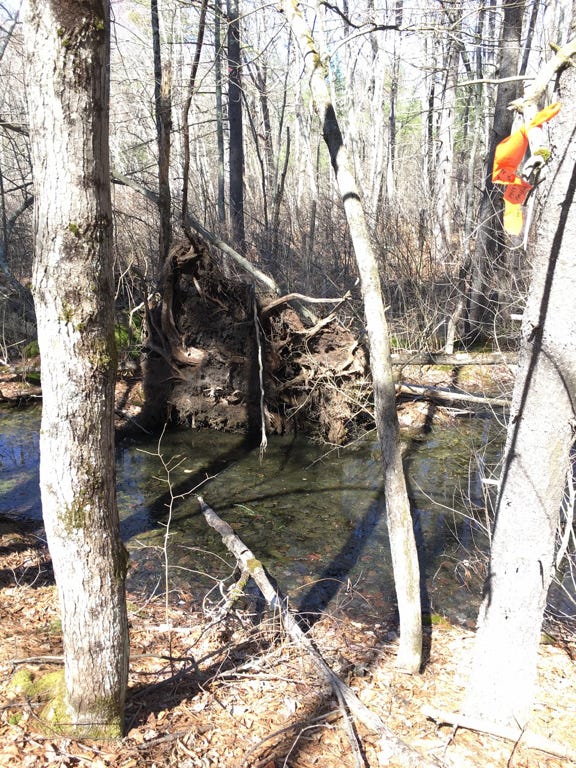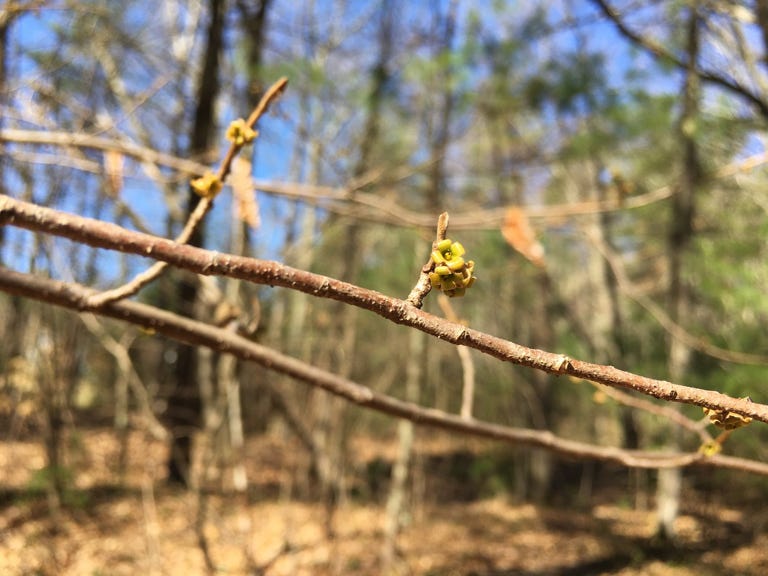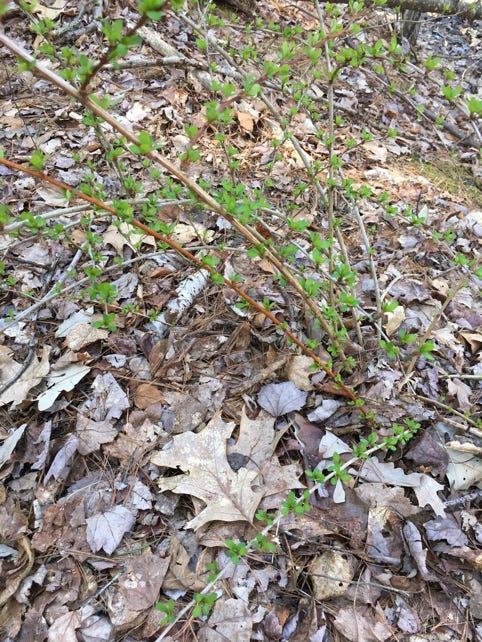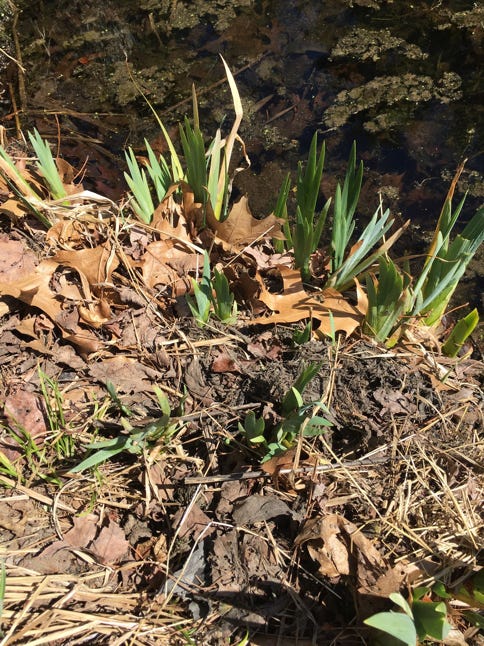West Side Trail (flagging April 9-25(ish)) to the south
Off of River Road, sort of opposite the town forest parking area. On the town trail maps
as #5 Walent Property/Westside Trail
drive down the dirt road past the signs for the West Side Trail and park in the grassy loop
For several years before the pandemic, I lead natural history walks sponsored by the Pepperell Conservation Commission and the Nashoba Conservation Trust. I hope to do more of these walks when it is safe to be together again, now I’m thinking September, but we’ll see.
But spring is here and plants flowering and leafing out, and showing who they are, and we want to get out and enjoy our trails and nature in town. I’m using the hope that other people would like to know what’s going on with the plants along our trails to get out on them myself. I’m going to pick a trail and tie orange flags to particular plants (or sometimes near them) with the names on them and sometimes some natural history observations. Because the flags are picking up on time sensitive points such as flowers or early leaves I’ll leave the flags out for about 2 weeks, then remove them from any given trail. I will plan to highlight which trails have labels at any given time on the website.
Mostly I will be noting changes in season of our native plants. But, I’ll also note some of the invasive plants with comments on their effects on the native plant communities.
General observations:
Ticks: just be careful to check yourself after a walk. Spraying insecticide on your clothes can deter them, but check anyway.
Poison Ivy: The oils are present year around, don’t grab the branches, roots or stems. Wash with a good soap after exposure.
Not all the early flowering flowers are on any given trail. Bloodroots and marsh marigolds can be seen from the old railroad trail near the Prescott St bridge (crossing the Nissitissit River). Park at the pull off and go SE (it’s MassWildlife property, open to the public). Walk towards the river, both types of spring plants are on the west side, marsh marigolds down by the water.
For the West Side Trail, I only put up flagging as far south as the open water. The trail continues to Rt. 119, with plants and occasional animals along the way. Flagging up on April 9, I’ll leave it through about April 25. I haven’t tagged everything interesting, look around as you go!
Around the parking area are young white pines and other shrubs size plants that are signs of succession – plants moving into areas that were clear not too many years ago.
1. Between the parking lot and trail: some large white pines with hairy poison ivy vines. Flagging not on the poison ivy! Keep in mind that the oils in poison ivy are always there – don’t grab these to look more closely. Poison ivy is native and belongs here (but we should be cautious around it). Birds like the white fruits and in eating and eliminating the seeds spread the plants around
2. On the south side of the drive there are many invasive shrubs, Morrow’s honeysuckle. It is growing in previously disturbed areas where its early leafing out gives it an advantage over many of the native species that evolved to leaf out slightly later, with late frosts that damage early leaves selecting for cautious plants.
3. Winter identifiable plants are still among the easiest to recognize now. There are clubmosses providing low ground cover along the trail.
4. When you get to the wetlands on either side of the trail look for large leaves of skunk cabbage, one of the early natives to emerge, and to provide forage for bears and other animals.
5. Look for white birch along the trail, a sign of young forest, these native trees don’t grow well in shade, they usually start in open sun. Even as they start to die, they provide habitat for many animals and fungus. This tree has bracket fungus and holes from woodpeckers looking for insects inside the tree.
6. Look for fallen trees, particularly in the wetlands. Their tip ups provide a diverse habitat for other species, deeper water where they emerge and root masses where annuals may find transient low competitive sites for quick growing.
7. There are good populations of wintergreen (teaberry) along the trail, some still have red fruits from last year.
8. The fall flowering native witch hazels have dried remains of the flowers on the stems where the dry fruits will develop.
9. Beaked hazel (a nice native shrub) has been flowering for a while, with separate male catkins spreading pollen into the air and small red female flowers that capture pollen and then produce the fruits.
10. A different native clubmoss, running or common clubmoss adds diversity to the forest.
11. When you get to the open water areas, the plants are different than many in the forest, these grow in the sun, and many only grow in full sun. And there are aquatic plants. Look for amphibian egg masses in the edges of the trail, even though there are fish in the open water these frog, toad, or salamander parents laid eggs in the possibility that some would survive in the shallow areas. Other animal signs here are beaver cut trees, shallow holes where turtles have laid eggs (and often had them excavated by raccoons, skunks, or other hungry predators. Turtles bask on downed trees and stumps in the water.
12. The islands next to the trail support a lot of birds, somewhat protected by the relative isolation on the islands.
13. Look around the ponds for red blushing trees along the edges, red maples in flower and fruit. Look up in the marshy parts of the woods to see the red maples as well, with some of their flowers dropped to the ground.
14. There are many native plant species along the open water, but there are also abundant invasive species here. There are remnants of last year’s growth of purple loosestrife, barberry with its early leaves, and what I suspect is a non-native iris (it will have yellow flowers, and really does get into all sorts of backwaters where I’d expect natives to prevail). I’ll be looking for this when it flowers.
This is as far as I flagged this year. The trail continues a lot further. Explore!

fallen Tree

witch hazel fruits

Japanese barberry, a non-native shrub that starts its leaves out earlier in the spring than native shrubs. It grows along stream sides and on moist soil, sun or shade.

An iris, probably the non-native that will have yellow flowers. Our native iris is purple. Both grow in wetlands. The non-native yellow iris is considered to be invasive and take up habitat that would otherwise support native species.
All rights reserved. All content on this site property of Nashoba Conservation Trust.
Do not copy or reproduce in any form for any reason without written permission from Nashoba Conservation Trust.